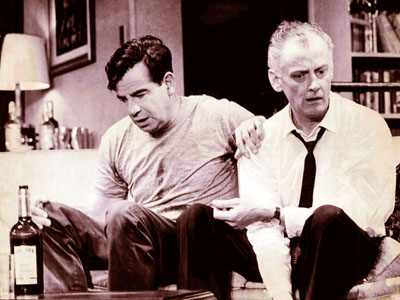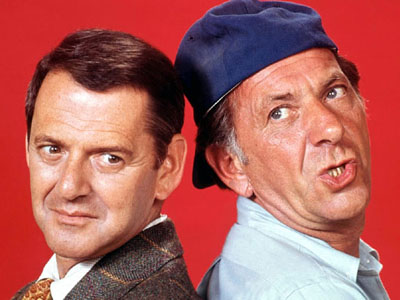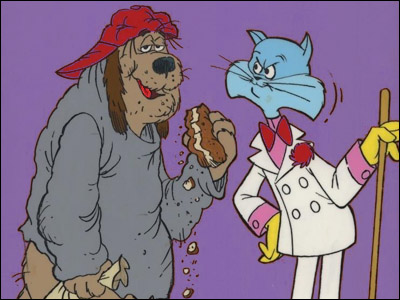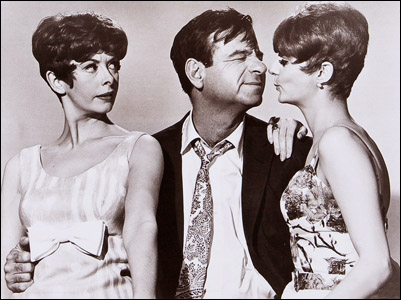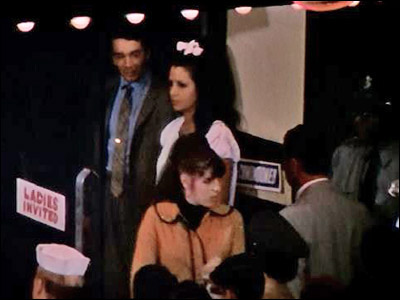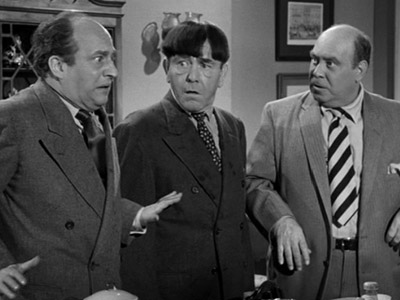This post ran on May 22, 2003 on this site, right after I'd attended a fine tribute for the late Red Buttons, who was very much not late at the time…
![]()
Once in a while, it's interesting to fact-check anecdotes. Last evening at the tribute to him, Red Buttons told the tale of what was to have been his first Broadway show. Here's how that story is told in what I guess is Red's official bio…
In 1941, Jose Ferrer plucked Red out of burlesque for his first Broadway show, The Admiral Had A Wife. The show was supposed to open on December 8, 1941, but it never did. The show was a farce comedy about Pearl Harbor — great timing!
Kurt Bodden writes me to note that 12/8/41 was a Monday and asks, "Is it plausible that a Broadway show would open on a Monday?" Well, yes, it is. A play called Golden Wings starring Fay Wray and dealing with soldiers actually did open in New York on 12/8/41. It closed after a big six performances.
But Kurt's query led me to do a little skulking-about on the Internet and I found this article about the Wilmington Playhouse in Wilmington, Delaware. Here's the relevant paragraph…
The Japanese bombed Pearl Harbor on December 7, 1941. As luck would have it, the Playhouse was scheduled to present the farce The Admiral Had A Wife on December 8. The premise: The wives of Pearl Harbor admirals were really running the Navy. Though the show was probably meant to offer comic relief, 30,000 Delaware men and women were braced for war, and they weren't laughing. The show was canceled.
So it sounds to me like the anecdote is true but that one teensy detail has been fudged a bit. The story as told in Red's bio does not actually say the show was supposed to open on Broadway on that date but that's implied. Of course, it's a better tale if we're led to believe that it was an opening on Broadway that was killed by the bombing of Pearl Harbor, as opposed to an opening in Wilmington that might have led to Broadway. Not a big point, really, and it's nice to see the essential part of the story confirmed from another source.
While we're on the topic of Broadway opening dates, here's another slight possible fact-check. The Marx Brothers made their Broadway debut with a revue called I'll Say She Is, which opened at the Casino Theater on May 19, 1924. The way the story has always been told is as follows: The show, which extensively toured the U.S. for its pre-Broadway shakedown, was a hodge-podge of vaudeville — the kind of thing that even the Marxes knew had no place on Broadway. They were more interested in the employment of the tour than in playing New York, and tried to put N.Y. off as long as possible. They figured if they opened there, the critics would murder them, the show would close, and they'd be unemployed. But the show's backer insisted, as did their mother, who longed to see her boys on the Great White Way, and who refused to believe that the town would not adore them.
Hoping to minimize the inevitable critical burial, the brothers arranged for their opening to coincide with that of a serious drama. The idea was that the first-string drama critics would go cover the other show and that the second-string critics would be dispatched to review the Marx opening. The assistants, it was hoped, would be kinder or at least less outraged to see a vaudeville show passed off as a Broadway musical. Groucho, Harpo, Chico and Zeppo especially hoped to avoid the withering condemnation of Alexander Woollcott, who was then the Drama Critic for the New York World and known for shredding that which offended his snobbish sensibilities.
Well, as the story is told, at the last minute the other play postponed its opening and the first-string critics, who were already in their tuxedos and primed for serious drama, found themselves at the Marx show instead. They were therefore even more annoyed than they might have been to attend I'll Say She Is, and most spent the first act planning how they would pan the proceedings. What stopped many of them was that Woollcott was not only present but madly in love with what he saw on stage, Harpo especially. He spent intermission gushing to his colleagues about how wonderful the show was, which influenced many to not write the expected "this show has no business being on Broadway" notices. He also wrote a famous rave review, almost wholly about Harpo, which helped make the show a hit.
That's more or less how history tells it. But as I looked up the opening dates relating to the other play above, I chanced onto the wrong page and noticed that not only did I'll Say She Is open on 5/19/24 but so did a pretty famous show called Blossom Time. This was a Shubert production which ran 592 performances and featured an all-star cast and the music of Franz Schubert. It was by any measure a much more important opening than that of the Marx Brothers. So is it really true about the first-string critics all winding up at the Marx show because they had nowhere else to go? And why was Woollcott there and not down the street at Blossom Time?
